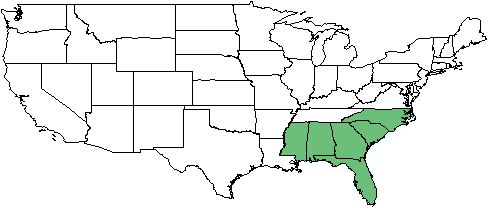Trilisa paniculata
| Trilisa paniculata | |
|---|---|

| |
| Photo by John Gwaltney hosted at Southeastern Flora.com | |
| Scientific classification | |
| Kingdom: | Plantae |
| Division: | Magnoliophyta - Flowering plants |
| Class: | Magnoliopsida - Dicots |
| Order: | Asterales |
| Family: | Asteraceae |
| Genus: | Trilisa |
| Species: | T. paniculata |
| Binomial name | |
| Trilisa paniculata (J.F. Gmel.) Herb. | |

| |
| Natural range of Trilisa paniculata from Weakley.[1] | |
Common Names: trilisa;[1] hairy chaffhead[2]
Contents
Taxonomic Notes
Synonym: Carphephorus paniculatus (J.F. Gmelin) Herbert.[3]
Description
T. paniculata is a dioecious perennial forb/herb.[2]
Distribution
This species occurs from southeastern North Carolina, south to southern Florida, and westward to the Florida panhandle and southern Alabama.[1]
Ecology
Habitat
T. paniculata occurs in savannas, bogs, oak-pine woods, and flatwoods.[1][4][5] It is also found in disturbed areas like roadsides.[6]
Phenology
In the southeastern and mid-Atlantic United States, flowering occurs from August through October and fruiting from September through November.[1]
Fire ecology
In Georgia cut over pine forests, percent coverage of T. paniculata decreases with the number of growing seasons since fire, from 0.8 after one season, to 0.2 after two and three seasons, and 0.1 after eight.[7] On the Wade Tract south Georgia, populations of Trilisa paniculata have been known to persist through repeated annual burns.[8]
Herbivory and toxicology
T. paniculata have been found in the stomachs of white-tailed deer in central peninsular Florida.[9]
Conservation, cultivation, and restoration
Cultural use
Photo Gallery
References and notes
- ↑ 1.0 1.1 1.2 1.3 1.4 Weakley AS (2015) Flora of the Southern and Mid-Atlantic States. Chapel Hill, NC: University of North Carolina Herbarium.
- ↑ 2.0 2.1 USDA NRCS (2016) The PLANTS Database (http://plants.usda.gov, 14 February 2018). National Plant Data Team, Greensboro, NC 27401-4901 USA.
- ↑ Weakley, A.S. 2015. Flora of the southern and mid-atlantic states. Working Draf of 21 May 2015. University of North Carolina at Chapel Hill, Chapel Hill, North Carolina.
- ↑ Northland College accessed using Southeastern Regional Network of Expertise and Collections (SERNEC) data portal. URL: http://sernecportal.org/portal/collections/index.php Last accessed: June 2021. Collectors: David J. Sieren. States and Counties: North Carolina: New Hanover.
- ↑ University of Mississippi, Thomas M. Pullen Herbarium accessed using Southeastern Regional Network of Expertise and Collections (SERNEC) data portal. URL: http://sernecportal.org/portal/collections/index.php Last accessed: June 2021. Collectors: W. H. Duncan. States and Counties: Georgia: McIntosh.
- ↑ University of North Carolina, Asheville accessed using Southeastern Regional Network of Expertise and Collections (SERNEC) data portal. URL: http://sernecportal.org/portal/collections/index.php Last accessed: June 2021. Collectors: J.D. Perry. States and Counties: North Carolina: Carteret.
- ↑ Lemon PC (1949) Successional responses of herbs in the longleaf-slash pine forest after fire. Ecology 30(2):135-145.
- ↑ Platt, W.J., R. Carter, G. Nelson, W. Baker, S. Hermann, J. Kane, L. Anderson, M. Smith, K. Robertson. 2021. Unpublished species list of Wade Tract old-growth longleaf pine savanna, Thomasville, Georgia.
- ↑ Harlow RF (1961) Fall and winter foods of Florida white-tailed deer. The Quarterly Journal of the Florida Academy of Sciences 24(1):19-38.